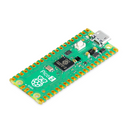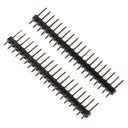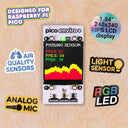Raspberry Pi Pico 2
by Raspberry Pi



A low cost, high-performance, secure microcontroller board built around Raspberry Pi's souped up new chip - RP2350.
With a higher core clock speed, double the on-chip SRAM, double the on-board flash memory, more powerful ARM cores, optional RISC-V cores, new security features, and upgraded interfacing capabilities, Raspberry Pi Pico 2 delivers a significant performance and feature boost, while retaining hardware and software compatibility with earlier members of the Raspberry Pi Pico series.
Raspberry Pi Pico 2 comes without header pins so you'll need to pick some up separately if you're planning on plugging it into into a breadboard or one of our Raspberry Pi Pico add-ons. Alternatively, you can buy the official headered version, which comes with pre-soldered pin headers and a pre-soldered debug connector (3 pin JST-SH).
New security features
RP2350 provides a comprehensive security architecture, built around Arm TrustZone for Cortex-M, and incorporating signed boot, 8KB of antifuse OTP for key storage, SHA-256 acceleration, a hardware TRNG, and fast glitch detectors. These features, including the secure boot ROM, are extensively documented and available to all users without restriction: this transparent approach, which contrasts with the “security through obscurity” offered by legacy vendors, allows professional users to integrate RP2350, and Raspberry Pi Pico 2, into products with confidence.
Dual-core, dual architecture
The unique dual-core, dual-architecture capability of RP2350 allows users to choose between a pair of industry-standard Arm Cortex-M33 cores, and a pair of open-hardware. Hazard3 RISC-V cores. Programmable in C / C++ and MicroPython, and with detailed documentation, Raspberry Pi Pico 2 is the ideal microcontroller board for enthusiasts and professional developers alike.
Specifications
- Form factor: 21 mm × 51 mm
- CPU: Dual Arm Cortex-M33 or dual RISC-V Hazard3 processors @150MHz
- Memory: 520 KB on-chip SRAM; 4 MB on-board QSPI flash
- Interfacing: 26 multi-purpose GPIO pins, including 4 that can be used for ADC
- Peripherals:
- 2 × UART
- 2 × SPI controllers
- 2 × I2C controllers
- 24 × PWM channels
- 1 × USB 1.1 controller and PHY, with host and device support
- 12 × PIO state machines
Documentation
-
Without Headers
SC1631£4.00 -
With Headers
SC1632£4.75
Extenders, headers and cables for Pico
Don't forget the headers!
-
 Pico Header Pack+ £1.50
Pico Header Pack+ £1.50
Great addons to go with your Pico / compatible board
Add features like displays, audio and more!
-
 Pico Enviro+ Pack+ £37.50
Pico Enviro+ Pack+ £37.50 -
 Pico Display Pack 2.8"+ £15.75
Pico Display Pack 2.8"+ £15.75 -
 Pico GFX Pack+ £13.75
Pico GFX Pack+ £13.75
Shop with confidence – we've been serving the hobbyist electronics, Maker, and retro gaming communities since 2012.
- Satisfaction or refund guarantee
- Worldwide shipping via mail or courier
- 57,000+ customer reviews
- Approved Raspberry Pi Reseller
- Secure website and payments




